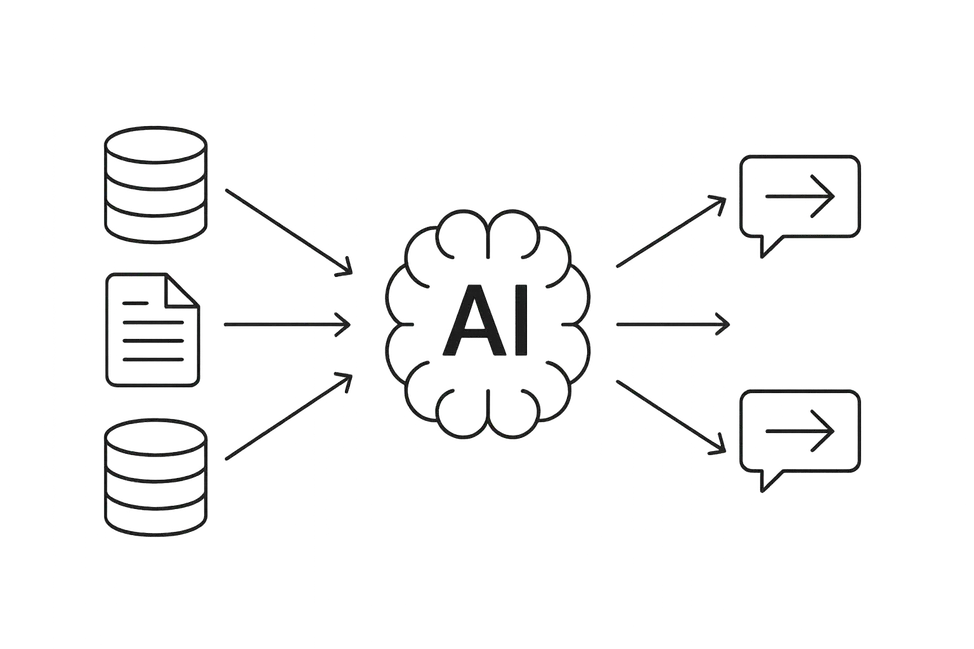Artificial Intelligence (AI) continues to revolutionize the business world, yet many organizations struggle to harness its full potential. A common challenge is ensuring AI can access and effectively use specific, up-to-date information to make accurate decisions. This is where Retrieval-Augmented Generation (RAG) steps in, transforming how businesses deploy AI by combining traditional retrieval techniques with advanced generative models.
What is Retrieval-Augmented Generation (RAG)?
Retrieval-Augmented Generation (RAG) is an AI architecture that enhances the decision-making ability of generative models by integrating external databases or knowledge sources. Imagine an AI as a talented researcher: traditional AI might rely solely on its existing “memory,” but a RAG system can actively pull up-to-date information from external sources whenever it needs additional context.
Think of RAG as your personal assistant preparing for an important meeting. Instead of relying solely on prior knowledge, your assistant quickly reviews the latest documents and reports right before the meeting, ensuring you’re perfectly informed. Similarly, RAG equips AI models with fresh, relevant information precisely when needed.
Why RAG is a Game-Changer for AI Applications
RAG dramatically enhances AI accuracy and relevance, enabling smarter decisions by providing timely and context-specific data. Traditional generative models are often limited by outdated or incomplete training data. RAG addresses this limitation by retrieving external, real-time information, significantly improving the AI’s responses.
Consider an AI-powered customer service chatbot. Without RAG, the chatbot might rely on static, pre-trained responses that quickly become outdated. With RAG, however, the chatbot retrieves the latest policies, product updates, or customer-specific information instantly, greatly improving customer satisfaction through precise, timely responses.
Key Components of a RAG System
To understand RAG clearly, it helps to explore its key components:
-
The Retriever
The retriever searches databases for relevant documents or information. This stage is like a skilled librarian quickly finding precisely the right books from a vast library. -
The Generator
The generator takes retrieved information and combines it with existing knowledge to create accurate, context-rich responses. It’s akin to a skilled writer synthesizing research into an engaging, informative summary. -
Integration and Feedback Loop
RAG systems continually refine their accuracy through a feedback loop, assessing how useful the retrieved information was and adjusting retrieval strategies accordingly.
How RAG Transforms Real-World Business Scenarios
Imagine a mid-sized financial services company that struggles with rapidly changing compliance regulations. Previously, compliance officers had to sift through thousands of pages manually. Implementing a RAG-enabled AI allows the company to instantly retrieve the latest regulatory guidelines, cross-reference these with internal documentation, and generate precise compliance summaries in seconds.
This not only speeds up compliance processes dramatically but also significantly reduces human error, allowing compliance officers to focus on more strategic responsibilities.
Steps to Implementing RAG in Your Business
Deploying RAG successfully involves a straightforward yet strategic approach:
-
Identify Your Information Needs
Begin by clarifying what types of information your AI must regularly access. Clearly define what you want your AI to retrieve and why. -
Structure Your Knowledge Base
Ensure your databases or external knowledge sources are clean, structured, and easily accessible. Just like maintaining a well-organized library, structured databases facilitate quicker retrieval. -
Choose and Train Your Retriever Model
Select appropriate retrieval models suited to your needs, such as vector-based semantic search engines (e.g., Pinecone or Weaviate), to ensure fast, accurate retrieval. -
Integrate and Optimize
Integrate the RAG system into your business operations, continuously monitoring performance. Regularly evaluate and refine the system to improve accuracy and efficiency.
Addressing Common Challenges in Implementing RAG
Implementing RAG, like any advanced technology, can face hurdles. Common challenges include data quality, retrieval accuracy, and integration complexity. Organizations can overcome these by focusing on rigorous data preparation, regular model tuning, and careful system integration.
Think of RAG implementation like setting up a new kitchen—initial organization is critical. Proper preparation of ingredients, precise recipes, and careful cooking methods ensure excellent outcomes. Similarly, meticulous initial setup and regular fine-tuning ensure RAG systems perform optimally over time.
Long-Term Benefits of Adopting RAG
Adopting RAG delivers sustained competitive advantages. It not only improves immediate AI accuracy but also future-proofs your AI strategy, enabling rapid adaptation to new information, market trends, and regulatory changes. Just as maintaining a vehicle ensures reliable performance over years, RAG ensures your AI systems remain precise, relevant, and valuable long-term.
Conclusion: Elevate Your AI Capabilities with RAG
Retrieval-Augmented Generation represents a significant evolution in AI technology, merging real-time retrieval with advanced generative capabilities to drive smarter, context-aware decisions. Implementing RAG isn’t just about technological innovation—it’s about empowering your organization to make faster, more informed decisions consistently.
At KN Process, we specialize in enabling organizations to harness cutting-edge AI capabilities like RAG effectively. Let’s transform your AI approach, making it smarter, faster, and aligned closely with your strategic goals.
